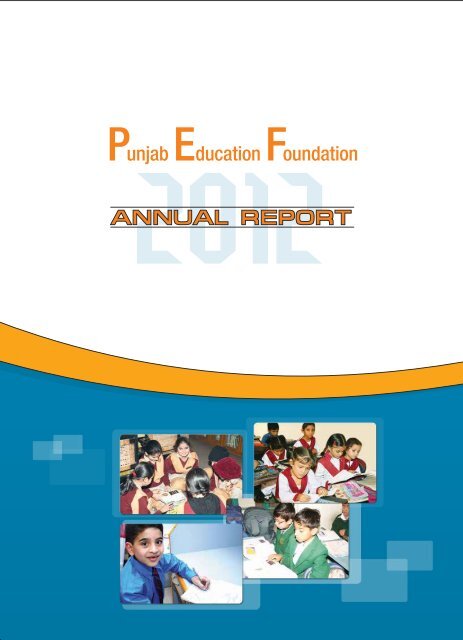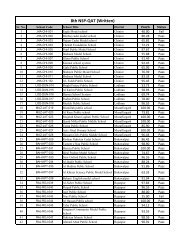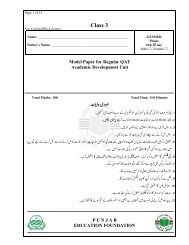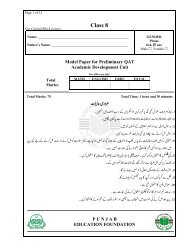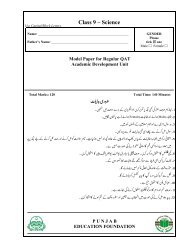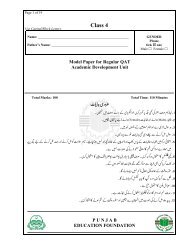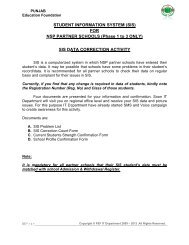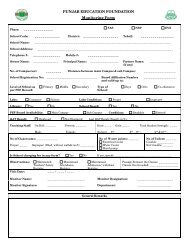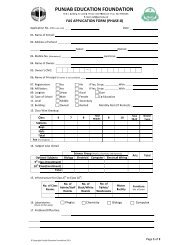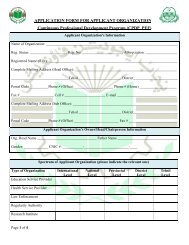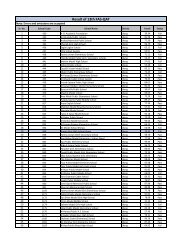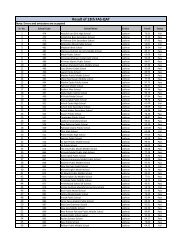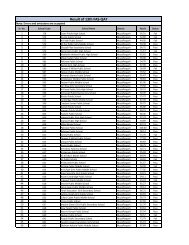PEF Annual Report 2012 - Punjab Education Foundation
PEF Annual Report 2012 - Punjab Education Foundation
PEF Annual Report 2012 - Punjab Education Foundation
You also want an ePaper? Increase the reach of your titles
YUMPU automatically turns print PDFs into web optimized ePapers that Google loves.
<strong>Punjab</strong><br />
<strong>2012</strong><br />
<strong>Education</strong> <strong>Foundation</strong><br />
ANNUAL REPORT
<strong>Punjab</strong> <strong>Education</strong> <strong>Foundation</strong><br />
PROMOTING QUALITY EDUCATION<br />
THROUGH PUBLIC PRIVATE PARTNERSHIP
<strong>Punjab</strong> <strong>Education</strong> <strong>Foundation</strong><br />
Contents<br />
Chairman’s Message 5<br />
Managing Director’s Message 6<br />
Introduction 7<br />
Mission Statement 7<br />
Objectives 8<br />
Governance Structure 9<br />
Board of Directors 10<br />
Board of Directors Committees 11<br />
Executive Management 12<br />
Offices 12<br />
Audit and Advisory 13<br />
Initiatives at a Glance 14<br />
Outreach of <strong>PEF</strong> Programs 15<br />
Year at a Glance 16<br />
<strong>PEF</strong> Programs 17<br />
<strong>Foundation</strong> Assisted Schools 17<br />
New School Program 22<br />
<strong>Education</strong> Voucher Scheme 24<br />
Continuous Professional Development Program 28<br />
Academic Development Unit 31<br />
Financials 32<br />
Audit <strong>Report</strong> 38<br />
Balance Sheet 40<br />
Income & Expenditures Account 41<br />
Statement of Comprehensive Income 42<br />
Statement of Cash Flows 43<br />
Statement of Changes in Fund Balances 44<br />
Notes to the Financial Statements 45
<strong>Punjab</strong> <strong>Education</strong> <strong>Foundation</strong><br />
Chairman’s Message<br />
It gives me immense pleasure to record my appreciation<br />
for the staff of <strong>Punjab</strong> <strong>Education</strong> <strong>Foundation</strong> (<strong>PEF</strong>) who is<br />
working hard to promote quality education in the<br />
remote and less developed areas with dedication & zeal.<br />
The efforts of (<strong>PEF</strong>) staff are especially praise worthy as<br />
they have enabled poor families to send their children to<br />
schools. And I believe that this is the most important<br />
revolution silently glittering our surroundings.<br />
The role of <strong>PEF</strong> is multifarious; it provides free education<br />
to the less privileged segments, arranges quality<br />
trainings for the teachers and school Administrators<br />
besides providing educational vouchers to child laborers<br />
and out of school children, who otherwise, have no other<br />
opportunity to attain education the fundamental right of<br />
every child.<br />
I believe the provision of free education is the most<br />
important right of every child and Government of <strong>Punjab</strong><br />
is committed to fulfill its obligation of providing free<br />
education to the children at their doorsteps. <strong>PEF</strong> efforts<br />
are helping to build sustainable partnerships with<br />
individuals and communities at large for optimum<br />
results.<br />
I hope the <strong>PEF</strong> official website will help to foster public<br />
understanding of our initiatives for strengthening<br />
Quality <strong>Education</strong> among the indigent strata. This would<br />
also help to boost public awareness about our programs.<br />
I would also like to take this opportunity to thank<br />
Government of the <strong>Punjab</strong> for its continuous guidance<br />
and steadfast support in supporting the efforts of <strong>PEF</strong>.<br />
We'll continue to seek out more opportunities that can<br />
make Pakistan a worth living place by utilizing on<br />
resources to support this noble cause.<br />
I believe together we can make Pakistan the land of<br />
opportunities for which our forefathers sacrificed their<br />
lives in 1947.<br />
Long live Pakistan<br />
Raja Muhammad Anwar<br />
5
<strong>Punjab</strong> <strong>Education</strong> <strong>Foundation</strong><br />
Managing Director’s Message<br />
<strong>PEF</strong> is a success story for three reasons:<br />
1. Serving the un-served population by reaching out to<br />
the out of school kids in <strong>Punjab</strong> (EVS Model).<br />
2. Serving the under-served population by providing<br />
quality assurance in partner schools (FAS Model).<br />
3. Serving the un-served areas by setting up schools<br />
where no school existed earlier (NSP Model).<br />
<strong>PEF</strong> operates in a Public Private Partnership mode. Rather<br />
than engaging in brick and mortar schemes, it acts as a<br />
catalyst to activate market forces of supply and demand.<br />
Demand for schools is created through awareness drives<br />
and household surveys whereas supply is stimulated by<br />
encouraging private entrepreneurs to set up schools.<br />
<strong>PEF</strong> strives to keep the cost of education affordable<br />
without compromising the quality of education. Cost of<br />
imparting quality education through <strong>PEF</strong> comes to less<br />
than US$ 5 per child per month.<br />
Dr. Ambreen Raza<br />
6
<strong>Punjab</strong> <strong>Education</strong> <strong>Foundation</strong><br />
Introduction<br />
<strong>Punjab</strong> <strong>Education</strong> <strong>Foundation</strong> (<strong>PEF</strong>/ <strong>Foundation</strong>) is<br />
an autonomous statutory body established under<br />
the <strong>Punjab</strong> <strong>Education</strong> <strong>Foundation</strong> Act of 1991 to<br />
encourage and promote gratis education in the<br />
poor strata through private sector operating on<br />
non-commercial / non-profit basis.<br />
<strong>PEF</strong> was restructured under the <strong>Punjab</strong> <strong>Education</strong><br />
<strong>Foundation</strong> Act-XII of 2004 for the promotion of<br />
education, especially encouraging and supporting<br />
the efforts of the private sector in providing<br />
education to the poor, through Public Private<br />
Partnership.<br />
Mission Statement<br />
Promotion of quality education through Public<br />
Private Partnership, encouraging and supporting<br />
the efforts of private sector through technical and<br />
financial assistance, innovating and developing new<br />
instruments to champion wider educational<br />
opportunities at affordable cost to the poor.<br />
Public sector<br />
Common<br />
Interest<br />
Private sector<br />
7
<strong>Punjab</strong> <strong>Education</strong> <strong>Foundation</strong><br />
Objectives<br />
• Provide financial assistance for the establishment,<br />
expansion, improvement, and management of<br />
educational institutions and allied projects.<br />
• Provide incentives to students, teachers, and <strong>Education</strong>al<br />
Institutions.<br />
• Promote public-private partnerships relating to<br />
education.<br />
• Provide technical assistance to <strong>Education</strong>al Institutions<br />
for testing policy interventions and innovative programs<br />
for replication.<br />
• Rank private educational institutions based on<br />
educational standards.<br />
• Raise funds through donations, grants, contributions,<br />
subscriptions etc.<br />
• Assist <strong>Education</strong>al Institutions in capacity building,<br />
including training of teachers.<br />
• Undertake any other function as may be assigned to it by<br />
the Board with the approval of the Government.<br />
8
<strong>Punjab</strong> <strong>Education</strong> <strong>Foundation</strong><br />
Governance Structure<br />
In conformity with the <strong>Punjab</strong> <strong>Education</strong> <strong>Foundation</strong> Act 2004, the<br />
Governance Model for the organization is shown below:<br />
Board of Directors<br />
Finance Committee of BOD<br />
Executive Committee of BOD<br />
Program Committee of BOD<br />
9
<strong>Punjab</strong> <strong>Education</strong> <strong>Foundation</strong><br />
Board of Directors<br />
The Board is primarily responsible for overseeing the <strong>Foundation</strong>s’ affairs, setting the vision, mission<br />
and its objectives and ensuring that the organization achieves its desired objectives. At present, Board<br />
consists of the following fifteen members headed by the Chairman, Mr. Raja Muhammad Anwar:<br />
Mr. Raja Muhammad Anwar<br />
Dr. Munawwar S. Mirza, Former Vice Chancellor, University of <strong>Education</strong><br />
Mr. Rana Muhammad Afzal, MPA<br />
Dr. Zafar Iqbal Qureshi, Lahore University of Management Sciences<br />
Ms. Saira Afzal Tarar, MNA<br />
Dr. Amjad Saqib, Vice Chairman, <strong>Punjab</strong> <strong>Education</strong> Endowment Fund<br />
Dr. Mira Phailbus, Former Principal, Kinnaird College Lahore<br />
Mr. Viqar Ahmed Khan, Chartered Accountant<br />
Secretary to Government of <strong>Punjab</strong>, Finance Department<br />
Secretary to Government of <strong>Punjab</strong>, School <strong>Education</strong> Department<br />
Secretary to Government of <strong>Punjab</strong>, Literacy and Non Formal<br />
Basic <strong>Education</strong> Department<br />
Secretary to Government of <strong>Punjab</strong>, Social Welfare Department<br />
Secretary to Government of <strong>Punjab</strong>, Planning and Development Department<br />
Vice Chancellor of the University of <strong>Education</strong> established by Government<br />
Managing Director, <strong>Punjab</strong> <strong>Education</strong> <strong>Foundation</strong><br />
Chairman<br />
Member<br />
Member<br />
Member<br />
Member<br />
Member<br />
Member<br />
Member<br />
Member<br />
Member<br />
Member<br />
Member<br />
Member<br />
Member<br />
Member/Secretary<br />
10
<strong>Punjab</strong> <strong>Education</strong> <strong>Foundation</strong><br />
Board of Directors Committees<br />
The Board Committees are responsible for overseeing the execution of decisions and strategies approved by the Board and<br />
to guide the Board in policy formation and strategic planning.<br />
Finance Committee<br />
The Finance Committee is responsible for the <strong>Foundation</strong>s’ financial matters, ensuring appropriateness of internal control<br />
structures and safeguarding of assets of the <strong>Foundation</strong> and direct the management in financial and internal controls related<br />
policies and procedures. Following is the list of members of the Finance Committee of Board of Directors:<br />
Dr. Zafar Iqbal Qureshi<br />
Convener<br />
Ms. Saira Afzal Tarar<br />
Member<br />
Mr. Rana Muhammad Afzal<br />
Member<br />
Dr. Mira Phailbus<br />
Member<br />
Secretary to Government of <strong>Punjab</strong>, Finance Department<br />
Member<br />
Secretary to Government of <strong>Punjab</strong>, Planning and Development Department<br />
Member<br />
Managing Director, <strong>Punjab</strong> <strong>Education</strong> <strong>Foundation</strong><br />
Member/Secretary<br />
Executive Committee<br />
The Executive Committee of the Board of Directors is responsible for executing the decisions and strategies approved by the<br />
Board relating to organizational structure and human resource management, including dispute resolution of the<br />
<strong>Foundation</strong>’s employees. Following is the list of members of the Executive Committee of Board of Directors:<br />
Mr. Raja Muhammad Anwar<br />
Dr. Munawwar S. Mirza<br />
Mr. Rana Muhammad Afzal<br />
Secretary to Government of <strong>Punjab</strong>, School <strong>Education</strong> Department<br />
Vice Chancellor of the University of <strong>Education</strong> established by Government<br />
Secretary to Government of <strong>Punjab</strong>, Planning and Development Department<br />
Managing Director, <strong>Punjab</strong> <strong>Education</strong> <strong>Foundation</strong><br />
Convener<br />
Member<br />
Member<br />
Member<br />
Member<br />
Member<br />
Member/ Secretary<br />
Program Committee<br />
The Program Committee is responsible for looking after the affairs of the programs initiated by the <strong>Foundation</strong>. Such affairs<br />
shall include, setting the direction of the programs in accordance with the vision of the Board, approving the strategies and<br />
overseeing the monitoring and evaluation activities in respect of the programs. Following is the list of members of the<br />
Program Committee of Board of Directors:<br />
Dr. Amjad Saqib<br />
Mr. Viqar Ahmed Khan<br />
Dr. Mira Phailbus<br />
Secretary to Government of <strong>Punjab</strong>, School <strong>Education</strong> Department<br />
Vice Chancellor of the University of <strong>Education</strong><br />
Secretary to Government of <strong>Punjab</strong>, Social Welfare Department<br />
Managing Director, <strong>Punjab</strong> <strong>Education</strong> <strong>Foundation</strong><br />
Convener<br />
Member<br />
Member<br />
Member<br />
Member<br />
Member<br />
Member/Secretary<br />
Name of Body<br />
No. of Meetings<br />
Held in FY 2011-12<br />
Frequency of Meetings<br />
Board of Directors<br />
Finance Committee<br />
Executive Committee<br />
Program Committee<br />
4<br />
3<br />
2<br />
2<br />
11
<strong>Punjab</strong> <strong>Education</strong> <strong>Foundation</strong><br />
Executive Management<br />
Dr. Ambreen Raza<br />
Mr. Salman Anwar Malik, (ACA)<br />
Mr. Aamir Iftikhar Ahmed<br />
Mr. Tanvir Ahmed Zaffar<br />
Managing Director<br />
Deputy Managing Director (Finance)<br />
Deputy Managing Director (HRM)<br />
Deputy Managing Director (Operations)<br />
Offices<br />
Head Office<br />
78-B1, Gulberg III, MM Alam Road, Lahore, Pakistan.<br />
Phone: 042-99268114-7<br />
Fax: 042-99268118<br />
Email: pef@pef.edu.pk<br />
Sub-Office Lahore<br />
58 - A II, Ghalib Market, Gulberg III, Lahore, Pakistan.<br />
Phone: 042-99263288-9<br />
Regional Office Rawalpindi<br />
A-2, Street No. 1, Officers Colony, Golra Road, Rawalpindi, Pakistan.<br />
Phone: 051-5476562<br />
Regional Office Multan<br />
25-G, Shah Rukne Alam Colony, Multan, Pakistan.<br />
Phone: 061-6780043<br />
12
<strong>Punjab</strong> <strong>Education</strong> <strong>Foundation</strong><br />
Audit and Advisory<br />
Internal Audit<br />
The Board of Directors had appointed the M/s. Ernst & Young Ford Rhodes Sidat Hyder & Co. Chartered Accounts as<br />
Internal Auditor of <strong>PEF</strong>.<br />
Ernst & Young (EY) is one of the largest professional service firms in the world and one of the "Big Four" accounting<br />
firms. Ernst & Young is a global organization of member firms with 167,000 employees in more than 140 countries,<br />
headquartered in London. EY has invested globally over 240 million pounds on its internal audit methodologies<br />
and tools, technology solutions, knowledge resources and development of experienced internal audit personnel in<br />
the last decade. EY has also 48% share of internal audit services globally.<br />
Quarterly Internal Audit <strong>Report</strong>s are presented to the Finance Committee and are then forwarded to the Board of<br />
Directors.<br />
External Audit<br />
For the Year Ended<br />
Duration of Audit<br />
External Auditors<br />
External Auditors<br />
Ranking<br />
June 30, <strong>2012</strong><br />
One year (July 1, 2011 to June 30, <strong>2012</strong>)<br />
M/s. Rahman Sarfaraz Rahim Iqbal Rafiq Chartered Accountants<br />
One of the leading firms in Pakistan<br />
Member firm of Russell Bedford International<br />
Category ‘A’ firm on State Bank of Pakistan panel of<br />
approved auditors<br />
Satisfactory quality control review (QCR) rating issued by<br />
the Institute of Chartered Accountant of Pakistan (ICAP)<br />
Auditors’ <strong>Report</strong><br />
Unqualified (clean report)<br />
13
<strong>Punjab</strong> <strong>Education</strong> <strong>Foundation</strong><br />
Initiatives at a Glance<br />
<strong>Foundation</strong><br />
Assisted<br />
School (FAS)<br />
<strong>Education</strong><br />
Voucher<br />
Scheme (EVS)<br />
New School<br />
Program<br />
(NSP)<br />
Continuous<br />
Professional<br />
Development<br />
Program (CPDP)<br />
14
<strong>Punjab</strong> <strong>Education</strong> <strong>Foundation</strong><br />
Outreach of <strong>PEF</strong> Programs<br />
All Districts of <strong>Punjab</strong><br />
No. of Partner schools in each district<br />
15
<strong>Punjab</strong> <strong>Education</strong> <strong>Foundation</strong><br />
Year at a Glance<br />
<strong>Foundation</strong> Assisted Schools (FAS)<br />
• Increase in per child fee from Rs.350/- to Rs.400/- up to Middle level classes.<br />
• Launch of Phase VII with 387 new schools.<br />
• Increase in FAS enrollment with approximately 233,000 students.<br />
• Class 5th & 8th students of FAS partner schools secured 31 positions in PEC examination.<br />
New School Program (NSP)<br />
• Launch of Phase IV with 159 new schools.<br />
• Increase in NSP enrollment with approximately 17,000 students.<br />
• Increment in financial assistance to <strong>PEF</strong>-NSP schools as per FAS standards.<br />
<strong>Education</strong> Voucher Scheme (EVS)<br />
• Increase in outreach of program with identification and coverage in 206 new areas for vouchers distribution.<br />
• Increase in registered vouchers with 100,000 students.<br />
• Increase in EVS partners with 409 schools.<br />
• Implementation of voucher security measures.<br />
Continuous Professional Development Program (CPDP)<br />
• 671 Continuous Teachers’ Development Program (CTDP) trainings conducted: Achievement of 93% target.<br />
• 296 School Leadership Development Program (SLDP) trainings conducted: Achievement of 62% target.<br />
• Restructuring of Teaching in Clusters by Subject Specialists (TICSS) Program to Subject Based Support<br />
Program (SBSP).<br />
• Launch of Skills Development Program (SDP) as a new initiative.<br />
Academic Development Unit (ADU)<br />
• Conduction of annual Quality Assurance Test (QAT) for all programs: 448,695 students covering 3014 schools<br />
all over <strong>Punjab</strong><br />
• Revision of content book for partner schools in accordance with the new books published by<br />
<strong>Punjab</strong> Textbook Board (PTB)<br />
• Review of teachers’ manuals developed by Directorate of Staff Development (DSD).<br />
16
<strong>Punjab</strong> <strong>Education</strong> <strong>Foundation</strong><br />
<strong>PEF</strong> Programs<br />
<strong>Foundation</strong> Assisted Schools (FAS)<br />
<strong>Foundation</strong> Assisted Schools (FAS) is a flagship program of <strong>Punjab</strong> <strong>Education</strong> <strong>Foundation</strong>. It ensures provision of<br />
quality education through Public Private Partnership. FAS provides financial assistance to private sector schools in<br />
cities, towns and far flung areas of the province and ensures free education to children from deprived strata of the<br />
society. FAS program was introduced in 2005 with a limited outreach to 54 partner schools in 6 districts. However,<br />
since 2008, <strong>PEF</strong> has given consistently focused attention to FAS program and it has been extended to all 36 districts<br />
of <strong>Punjab</strong> working with 2,150 partner schools catering to the needs of the one million deserving students.<br />
FAS Achievements and Progress in FY 2011-12<br />
• Students from FAS partner schools have secured top positions 5 th and 8 th class PEC examinations. The overall<br />
strength of <strong>PEF</strong> schools is only 3% of the total public and private schools appearing in PEC examinations. In<br />
2011 PEC examinations, FAS students of 5 th class secured 21 top positions (which is 24% of top positions in the<br />
province) & students of 8 th class secured top 10 positions (which is 14% of total top positions in the province).<br />
• Launch of Student Information System (SIS):<br />
Student Information System (SIS) is an integrated management system that helps<br />
partner schools in recording, enumerating & arranging students information. It<br />
important to note that <strong>PEF</strong> is pioneer in implementing integrated MIS for private<br />
schools in <strong>Punjab</strong>.<br />
• Launch of Phase VII<br />
• Selection criteria for FAS Phase VII expansion was<br />
advertised in national dailies across <strong>Punjab</strong> and<br />
eligible candidate schools that qualified<br />
preliminary Quality Assurance Test were later<br />
physically inspected and scrutinized before<br />
signing Partnership Agreements.<br />
• Phase VII expansion program was launched in<br />
April <strong>2012</strong>, as a result of which FAS program<br />
outreached the 36 districts of <strong>Punjab</strong>.<br />
• Increment in Financial Assistance to FAS Partner Schools:<br />
During the financial year 2011-12, tuition fee for middle level students has been increased to Rs. 400/- from<br />
Rs. 350/-. The level wise fee details are given hereunder:<br />
• Rs. 400/- Per Student for Elementary Level & Secondary Level Arts Students.<br />
• Rs. 500/- Per Student for Secondary Level Science & Higher Secondary Level Arts Students.<br />
• Rs. 700/- Per Student for Higher Secondary Level Science Students.<br />
17
<strong>Punjab</strong> <strong>Education</strong> <strong>Foundation</strong><br />
• FAS Phase VII expansion has added 387 new schools to<br />
FAS program.<br />
FAS Partner Schools<br />
1,763<br />
2,150<br />
2010-11 2011-12<br />
District wise increase in FAS Partner schools is exhibited hereunder:<br />
FAS Schools Year 2011 Year <strong>2012</strong><br />
3<br />
4<br />
4<br />
4<br />
50<br />
60<br />
36<br />
36<br />
16<br />
21<br />
52<br />
20<br />
24<br />
35<br />
46<br />
41<br />
58<br />
90<br />
125<br />
143<br />
186<br />
201<br />
257<br />
281<br />
Attock<br />
Bahawalpur<br />
Bhakkar<br />
Bahawalnagar<br />
Chakwal<br />
Chiniot<br />
D.G. Khan<br />
Gujrat<br />
Jehlum<br />
Jhang<br />
Khushab<br />
Lahore<br />
18
<strong>Punjab</strong> <strong>Education</strong> <strong>Foundation</strong><br />
District wise increase in FAS Partner schools is exhibited hereunder:<br />
FAS Schools<br />
Year 2011 Year <strong>2012</strong><br />
40<br />
53<br />
4<br />
6<br />
34<br />
48<br />
7<br />
9<br />
9<br />
12<br />
29<br />
34<br />
23<br />
27<br />
33<br />
44<br />
117<br />
137<br />
106<br />
114<br />
189<br />
230<br />
219<br />
262<br />
Layyah<br />
Lodhran<br />
Mandi Bahauddin<br />
Mianwali<br />
Multan<br />
Muzaffargarh<br />
Nankana Sahib<br />
Narowal<br />
Okara<br />
Pakpattan<br />
Rahimyar Khan<br />
Rajanpur<br />
FAS Schools Year 2011 Year <strong>2012</strong><br />
5<br />
9<br />
0<br />
89<br />
0<br />
0<br />
0<br />
1<br />
0<br />
0<br />
1<br />
0<br />
3<br />
4<br />
7<br />
5<br />
6<br />
25<br />
26<br />
22<br />
28<br />
18<br />
16<br />
69<br />
Rawalpindi<br />
Sargodha<br />
Sheikhupura<br />
Sialkot<br />
Faisalabad<br />
Gujranwala<br />
Khanewal<br />
Sahiwal<br />
T.T. Singh<br />
Hafizabad<br />
Kasur<br />
Vehari<br />
19
<strong>Punjab</strong> <strong>Education</strong> <strong>Foundation</strong><br />
Increase in FAS Enrollment:<br />
Launch of Phase VII has added 100,000 new students to the program in addition to new admissions in<br />
existing partner schools.<br />
Enrollment<br />
777,507<br />
1,010,509<br />
2010-11<br />
2011-12<br />
District wise increase in FAS Partner schools is exhibited hereunder:<br />
FAS Enrollment<br />
Year 2011 Year <strong>2012</strong><br />
869<br />
1,732<br />
112,123<br />
22,589<br />
27,110<br />
74,980<br />
96,958<br />
16,167<br />
18,262<br />
142,026<br />
6,939<br />
10,186<br />
14,966<br />
34,942<br />
9,745<br />
13,831<br />
900<br />
1,198<br />
41,340<br />
64,926<br />
15,811<br />
22,539<br />
13,863<br />
29,175<br />
Attock<br />
Bahawalpur<br />
Bhakkar<br />
Bahawalnagar<br />
Chakwal<br />
Chiniot<br />
D.G. Khan<br />
Gujrat<br />
Jehlum<br />
Jhang<br />
Khushab<br />
Lahore<br />
20
<strong>Punjab</strong> <strong>Education</strong> <strong>Foundation</strong><br />
FAS Enrollment Year 2011 Year <strong>2012</strong><br />
8,786<br />
21,044<br />
50,042<br />
70,820<br />
903<br />
1,914<br />
9,451<br />
19,316<br />
2,317<br />
3,690<br />
3,659<br />
5,852<br />
8,091<br />
15,349<br />
9,459<br />
13,178<br />
9,579<br />
18,139<br />
29,271<br />
55,297<br />
104,698<br />
126,167<br />
92,415<br />
137,491<br />
Layyah<br />
Lodhran<br />
Mandi Bahauddin<br />
Mianwali<br />
Multan<br />
Muzaffargarh<br />
Nankana Sahib<br />
Narowal<br />
Okara<br />
Pakpattan<br />
Rahimyar Khan<br />
Rajanpur<br />
FAS Enrollment<br />
Year 2011 Year <strong>2012</strong><br />
1,561<br />
3,211<br />
6,889<br />
3,005<br />
3,060<br />
1,778<br />
9,542<br />
12,608<br />
15,733<br />
-<br />
-<br />
822<br />
-<br />
36,068<br />
4,756<br />
-<br />
468<br />
-<br />
812<br />
-<br />
293<br />
-<br />
4,858<br />
25,244<br />
Rawalpindi<br />
Sargodha<br />
Sheikhupura<br />
Sialkot<br />
Faisalabad<br />
Gujranwala<br />
Khanewal<br />
Sahiwal<br />
T.T. Singh<br />
Hafizabad<br />
Kasur<br />
Vehari<br />
21
<strong>Punjab</strong> <strong>Education</strong> <strong>Foundation</strong><br />
New School Program (NSP)<br />
New School Program was initiated as pilot project in March 2008 to allure private sector entrepreneurs to set up<br />
schools in distant and remote areas of the province where private schools are scarce or absent altogether.<br />
New School Program not only facilitates the enrollment of out of school children but also ensures their retention<br />
through effective policies, monitoring & evaluation, capacity building and Quality Assurance Test.<br />
• Financial assistance to develop educational infrastructure by giving Rs.400 per student to the maximum of 300<br />
students per school.<br />
• Grace period of six months to build infrastructure of school by giving Rs.400 per child for 50 students even if<br />
there is no student enrolled at the time of school’s selection.<br />
• Continuity of partnership is based on performance in Quality Assurance Test.<br />
• Partner schools will not charge anything in any form from the students under any circumstances.<br />
School’s Selection Criteria<br />
• The applicant may apply for setting up a school in accessible location where there is no public or private school<br />
within 2 km radius.<br />
• Existence of non formal schools within a radius of 2 km from the proposed site for school will be over looked,<br />
existence of boys school in 2 Km radius for opening of girl school and vice versa shall be over looked.<br />
• Similarly, if only primary school exists within 2 km of proposed site, elementary/ high school may be opened at<br />
the proposed site.<br />
• Applicant and school Principal must be educated having acquired at least intermediate level qualification.<br />
• There is no minimum enrollment limit at the time of school selection. However, preference is given on the basis<br />
of following in school selection:<br />
a) Functional schools in owned building<br />
b) Non functional schools in owned building<br />
c) Functional schools in rented building<br />
Expansion in FY 2011-12<br />
June 2011<br />
June <strong>2012</strong><br />
Increase<br />
Students Enrollment<br />
19,585<br />
37,073<br />
17,488<br />
No. of NSP Partner Schools<br />
195<br />
354<br />
159<br />
22
<strong>Punjab</strong> <strong>Education</strong> <strong>Foundation</strong><br />
Phase IV of NSP was launched in <strong>2012</strong> to expand the outreach of the program. After due process, 159 new schools<br />
were partnered with for the provision of free education to deserving children living in far flung rural areas.<br />
Increase in Enrollment - 89%<br />
40,000<br />
30,000<br />
20,000<br />
10,000<br />
0<br />
June 2011 June <strong>2012</strong><br />
Increase in No. of Partner Schools - 82%<br />
400<br />
350<br />
300<br />
250<br />
200<br />
150<br />
100<br />
50<br />
0<br />
June 2011 June <strong>2012</strong><br />
23
<strong>Punjab</strong> <strong>Education</strong> <strong>Foundation</strong><br />
<strong>Education</strong> Voucher Scheme (EVS)<br />
<strong>Education</strong> Voucher Scheme was launched in 2006 with the aim to benefit children belonging to less affluent and<br />
underprivileged areas, who otherwise cannot get education due to financial and social constraints. This scheme<br />
has got tremendous response due to its beneficial effect on poor segments of the society. <strong>Education</strong> Voucher<br />
Scheme employs innovative techniques to increase enrollment and enhance the quality of education. Main<br />
features of this initiative are:<br />
Low Cost <strong>Education</strong><br />
• Average cost of Rs. 350 per student, much lower than traditional programs<br />
• No upfront cost of setting up new schools (e.g. infrastructure)<br />
Superior Targeting<br />
• Mechanisms to ensure that subsidies are extended to the most deserving e.g. out of school and high risk<br />
children of deserving/ slums/ underprivileged areas<br />
Better Quality Outcomes<br />
• Better quality outcomes maintained and demonstrated by regular testing of students through Quality<br />
Assurance Test.<br />
Monitoring and Evaluation (M&E)<br />
• Internal M&E Mechanism for periodic evaluations<br />
• External M&E Mechanism for an independent check on program and policies implementation<br />
With a view to promote affordable quality education for the less privileged and disenfranchised segments of<br />
society, <strong>Punjab</strong> <strong>Education</strong> <strong>Foundation</strong> has planned to further expand its EVS program in all districts of the<br />
province.<br />
The voucher is redeemable against payment of fee in the private educational institutions partnered with <strong>PEF</strong><br />
under EVS program. EVS enables the children of age 4-17 years from poorest families to get free education in<br />
their nearest EVS Partner private schools of their own choice. Vouchers are issued after every 4 months through<br />
distribution camps set up in different areas. The vouchers are redeemed from schools within a specified period<br />
after distribution. Payment is made to schools in the last month of the period of validity of the vouchers.<br />
Selection Process/ Strategy<br />
Selection of area is the most significant segment of voucher scheme wherein household surveys are conducted<br />
to identify the number of children available in specific geographic boundaries as per voucher eligibility criteria.<br />
24
<strong>Punjab</strong> <strong>Education</strong> <strong>Foundation</strong><br />
During analysis most deserving children are identified and registered for voucher scheme. Children are<br />
registered on the basis of criteria given below:<br />
• Out of school children<br />
• Drop outs<br />
• Never went to school<br />
• Child Laborers<br />
• Orphans<br />
• Children of widows, Divorces, single parents<br />
• Parents with special needs<br />
• Children at risk of dropping out<br />
Definition of Out of School Child: A child of school<br />
going age as defined by the State if not attending any<br />
formal educational institution.<br />
Definition of Drop out: A child of school going age<br />
as defined by the State if not attending any formal<br />
educational institution for three months (excluding<br />
summer vacations).<br />
Definition of Child Labor: A child of school going<br />
age as defined by the State either attending or not<br />
attending any formal or non formal educational<br />
institution but engaged in any kind of labor activity.<br />
Simultaneously, school selection process is initiated by inviting expressions of interest from schools of selected<br />
areas through advertisement. Previously, preliminary Quality Assurance Test of the shortlisted schools was<br />
conducted to assess quality standards through students’ learning outcome assessments. The schools who<br />
qualified the Quality Assurance Test were inspected for assessment of infrastructure & educational environment<br />
and agreements were signed with the schools recommended for partnership after physical inspection reports.<br />
Recently, criteria have been revised wherein preliminary Quality Assurance Test is exempted for selection<br />
purpose.<br />
Continuity of partnership is dependent on results of Quality Assurance Tests as per required percentages. In case<br />
of two consecutive failures in QAT, the partnership discontinues.<br />
Expected Outcomes<br />
• Decrease in out of school children<br />
• Increase in primary completion rate<br />
• Increase in access to schools in vicinity<br />
• Competitive environment among private institutions to retain maximum students/ enhanced retention<br />
• Competition to improve quality of education<br />
• Increase in enrollment at Primary level partner schools<br />
• Increase in female enrollment<br />
• Better employment opportunities if linked with Skill Development Program<br />
• Women Empowerment: Increase in employment opportunity for female teachers<br />
• Improvement in students learning outcomes<br />
25
<strong>Punjab</strong> <strong>Education</strong> <strong>Foundation</strong><br />
EVS Achievements in FY 2011-12<br />
• During the year, 206 new areas were identified as worthy of voucher distribution as per area selection criteria.<br />
• 100,000 new students registered.<br />
• 409 schools selected for partnership.<br />
• Security measures have been implemented in order to streamline process of voucher’s distribution up to<br />
redemption.<br />
• Guidelines prepared and shared with partner schools in order to create better understanding of the process<br />
among school owners and their management.<br />
Periodic Progress<br />
No. of Operational Areas<br />
235<br />
87<br />
1 5 5 5<br />
29<br />
2006<br />
2007 2008 2009 2010 2011 <strong>2012</strong><br />
No. of EVS Schools<br />
576<br />
263<br />
153<br />
11<br />
35<br />
52<br />
69<br />
2006 2007 2008 2009 2010 2011 <strong>2012</strong><br />
26
<strong>Punjab</strong> <strong>Education</strong> <strong>Foundation</strong><br />
Vouchers Redemption During FY 2011-12<br />
Districts with Redemption > 90%<br />
100%<br />
98%<br />
97%<br />
96%<br />
95%<br />
95%<br />
91%<br />
90%<br />
90%<br />
Chakwal<br />
Pakpattan<br />
Sahiwal<br />
Narowal<br />
Jhang<br />
D.G Khan<br />
Hafizabad<br />
Attock<br />
Lodhran<br />
Districts with Redemption < 70%<br />
44%<br />
46%<br />
57% 61% 61%<br />
67%<br />
16% 18%<br />
Sheikhupura<br />
Gujrat<br />
Mianwali<br />
Sialkot<br />
Bhakkar<br />
Rawalpindi<br />
Khushab<br />
Faisalabad<br />
27
<strong>Punjab</strong> <strong>Education</strong> <strong>Foundation</strong><br />
Continuous Professional Development Program (CPDP)<br />
Continuous Professional Development Program was launched in August 2005. CPDP was designed to contribute<br />
towards the aim of <strong>PEF</strong> to promote quality education by providing technical assistance in the form of trainings<br />
and services of Subject Specialists (SS) to low cost private education sector.<br />
Four programs are operational under the umbrella of CPDP:<br />
Continuous Teachers’ Development Program (CTDP)<br />
By keeping in view the importance of professional development of teachers, CTDP was launched in August 2005<br />
for the training of primary school teachers of low cost private sector schools with particular emphasis on <strong>PEF</strong><br />
Partner schools. Major focus of the trainings remains on the content knowledge of different subjects like English,<br />
Mathematics and Science. At present, it focuses on teachers’ training of <strong>PEF</strong> Partner schools only.<br />
School Leadership Development Program (SLDP)<br />
In order to sensitize school principals and owners to facilitate trained teachers to incorporate newly learnt<br />
teaching techniques into their classroom practices, <strong>Punjab</strong> <strong>Education</strong> <strong>Foundation</strong> introduced an initiative under<br />
the umbrella of CPDP by the name of SLDP in February 2007. It was decided that Principals/ Vice-principals/ Head<br />
Teachers of <strong>PEF</strong> Partner schools shall be trained on administration and management of the school through SLDP.<br />
Subject Based Support Program (SBSP)<br />
SBSP was launched as Teaching in Clusters by Subject Specialists (TICSS) in 2006, with the aim of providing<br />
services of qualified and competent Subject Specialists (SS) to low cost secondary schools in rural and less<br />
affluent urban areas. Each SS provides services at a cluster of two schools for duration of one academic year. At<br />
present the program is known by the name Subject Based Support Program where each SS is allocated one<br />
school per academic year to work on School Improvement Plan in collaboration with the school head and staff.<br />
The services of SS are provided in subjects of English, Mathematics, Physics, Chemistry and Biology to low cost<br />
non <strong>PEF</strong> Partner schools.<br />
Skills Development Program (SDP)<br />
Different programs of <strong>PEF</strong> laid emphasis on the need of a skill based program for the students of our partner<br />
schools. To explore avenues in this dimension of education, Skills Development Program was initiated in March<br />
2011 for the provision of vocational orientation to the students of age 14 and above, in our partner schools.<br />
Despite a successful launch, the program was halted due to lack of budget provision in <strong>2012</strong>.<br />
28
<strong>Punjab</strong> <strong>Education</strong> <strong>Foundation</strong><br />
Plan for FY 2011-12<br />
Type of Expenses<br />
CTDP<br />
SLDP<br />
SBSP (SS Salary)<br />
SDP<br />
Trainings Planned<br />
720<br />
480<br />
240<br />
Trainings planned to<br />
cover 5,000 students<br />
Estimated Budget (Rs.)<br />
56,520,000<br />
14,400,000<br />
140,760,000<br />
40,000,000 @ the<br />
cost of Rs. 8,000 each<br />
Execution of Plan<br />
Details of the execution of plan in actual during FY 2011-12 are as follows:<br />
CTDP<br />
Training Level<br />
No. of Trainings<br />
Schools Benefitted<br />
Teachers Benefitted<br />
Level 1<br />
349<br />
1,295<br />
11,496<br />
Level II<br />
322<br />
822<br />
6,760<br />
Total<br />
671<br />
2,117<br />
18,256<br />
SLDP<br />
Training Level<br />
No. of Trainings<br />
Schools Benefitted<br />
Teachers Benefitted<br />
Level 1<br />
138<br />
1,021<br />
2,261<br />
Level II<br />
158<br />
1,012<br />
2,251<br />
Total<br />
296<br />
2,033<br />
4,512<br />
29
<strong>Punjab</strong> <strong>Education</strong> <strong>Foundation</strong><br />
Graphical representation of CTDP and SLDP actual versus targeted is as under:<br />
800<br />
700<br />
600<br />
500<br />
400<br />
300<br />
200<br />
100<br />
0<br />
Execution of Plan for FY 2011-12<br />
Trainings planned<br />
Trainings conducted<br />
CTDP<br />
SLDP<br />
CTDP achieved 93% of its target and trained a large number of Primary level teachers from FAS partner schools.<br />
Similarly for SLDP, 62% target was achieved. A number of SLDP trainings were cancelled due to non availability<br />
of school principals and less number of participants to complete a training batch in a cluster.<br />
SBSP<br />
Year No. of SS No. of Schools No. of Districts<br />
No. of Students<br />
Benefitted<br />
July to Dec. 2011<br />
88<br />
176<br />
24<br />
10,560<br />
Jan. to June <strong>2012</strong><br />
61<br />
61<br />
23<br />
6,100<br />
TICSS program was re-structured as SBSP on 3 rd February, <strong>2012</strong> It was decided in the same meeting of Program<br />
Committee that SBSP shall be expanded to other districts and further hiring of Subject Specialists shall be<br />
done after successful implementation of the new SBSP.<br />
SDP<br />
No. of Courses<br />
No. of Students<br />
Benefitted<br />
No. of Schools<br />
Districts<br />
33 811 62<br />
Lahore, Multan, Sialkot,<br />
Faisalabad, Vehari, Bahawalpur<br />
30
<strong>Punjab</strong> <strong>Education</strong> <strong>Foundation</strong><br />
Academic Development Unit (ADU)<br />
By conducting Quality Assurance Tests, the Academic Development Unit of <strong>Punjab</strong> <strong>Education</strong> <strong>Foundation</strong> is<br />
particularly responsible to ensure the provision of quality education to all partner schools working under its<br />
programs i.e. FAS, EVS, NSP and SBSP. Previously, these tests were conducted biannually but from the academic<br />
year <strong>2012</strong>-2013, one comprehensive testing activity was held for each program.<br />
The reason of this modification is in pursuance of the decision of Board, to conduct only one QAT in an<br />
academic year for all programs (NSP, FAS, EVS and SBSP).<br />
The new model of QAT (from biannual to single comprehensive testing) was applied and administered for all<br />
the programs. The Academic Development Unit (ADU) has also managed and conducted the 11 th EVS, 6 th SBSP<br />
and 8 th NSP written & NSP Phase IV oral QAT. Thoroughly.<br />
During the comprehensive testing for 13 th FAS QAT (Phase-I, Phase-II), SBSP, NSP and EVS QATs, a total of<br />
448,695 students were covered from 3,014 schools all over <strong>Punjab</strong>.<br />
The detail is shown in the following table:<br />
Program<br />
FAS (Phase I & II)<br />
EVS<br />
NSP (Written)<br />
SBSP<br />
NSP (Oral)<br />
No. of Schools<br />
2300<br />
253<br />
193<br />
47<br />
221<br />
No. of Students<br />
425,000<br />
1,946<br />
9,582<br />
4,432<br />
7,735<br />
31
Financials
<strong>Punjab</strong> <strong>Education</strong> <strong>Foundation</strong><br />
Budget Utilization in Last Five Years<br />
Description<br />
2011-12 2010-11<br />
2009-10 2008-09 2007-08<br />
Rs. In Million<br />
Expenditures<br />
4,848<br />
3,555<br />
2,763<br />
2,112<br />
1,285<br />
Budget<br />
6,000<br />
4,500<br />
4,000<br />
3,000<br />
1,800<br />
% of Budget Utilization<br />
81%<br />
79%<br />
69%<br />
70%<br />
71%<br />
Rs. In Million<br />
7,000<br />
6,000<br />
5,000<br />
4,000<br />
3,000<br />
2,000<br />
Budget<br />
Expenditures<br />
1,000<br />
2011-12<br />
81%<br />
2010-11<br />
79%<br />
2009-10<br />
69%<br />
2008-09<br />
70%<br />
2007-08<br />
71%<br />
33
<strong>Punjab</strong> <strong>Education</strong> <strong>Foundation</strong><br />
Variance Analysis: Actual Vs Budgeted Expenditures<br />
Description<br />
Actual<br />
Expenditures<br />
Budgetary<br />
Allocation<br />
% of Budget<br />
Utilization<br />
(Rs.)<br />
<strong>Foundation</strong> Assistance to Schools<br />
3,840,926,971<br />
4,384,128,000<br />
88%<br />
New School Program<br />
111,854,600<br />
337,476,000<br />
33%<br />
<strong>Education</strong> Voucher Scheme<br />
197,022,950<br />
250,507,000<br />
79%<br />
Academic Development Unit<br />
52,203,704<br />
93,972,000<br />
56%<br />
Free PTB Text Books<br />
259,651,555<br />
500,000,000<br />
52%<br />
Continuous Professional Development Program<br />
116,685,187<br />
155,367,000<br />
75%<br />
Brain of <strong>Punjab</strong><br />
-<br />
3,000,000<br />
0%<br />
Seminars, Workshops and Symposiums &<br />
Capacity Building of <strong>PEF</strong> Staff<br />
2,673,706<br />
26,324,000<br />
10%<br />
Program Related Expenditures<br />
141,678,665<br />
156,920,000<br />
90%<br />
Administrative & General Expenditures<br />
122,020,593<br />
151,585,000<br />
80%<br />
7,000<br />
6,000<br />
5,000<br />
4,000<br />
3,000<br />
2,000<br />
1,000<br />
Budget Utilization for FY 2011-12<br />
(Rs. In Million)<br />
Budgetary Allocation<br />
Actual Expenditures<br />
Program<br />
Expenditures<br />
80%<br />
Program Related Administrative &<br />
Expenditures General<br />
90% Expenditures<br />
80%<br />
34
<strong>Punjab</strong> <strong>Education</strong> <strong>Foundation</strong><br />
Budgeted Vs Actual Expenditures FY 2010-11<br />
Budgetary Allocation for FY 2011-12<br />
3% 2%<br />
Program Expenditures<br />
Program Related<br />
Expenditures<br />
95%<br />
Administrative &<br />
General Expenditures<br />
Actual Expenditures for FY 2011-12<br />
2.9% 2.5%<br />
Program Expenditures<br />
Program Related<br />
Expenditures<br />
94.6%<br />
Administrative &<br />
General Expenditures<br />
35
<strong>Punjab</strong> <strong>Education</strong> <strong>Foundation</strong><br />
Comparison of Actual Expenditures for FY 2010-11 Vs FY 2011-12<br />
Description<br />
<strong>Foundation</strong> Assisted Schools<br />
New School Program<br />
<strong>Education</strong> Voucher Scheme<br />
Academic Development Unit<br />
Continuous Teachers Development Program<br />
School Leadership Development Program<br />
Subject Based Support Program<br />
Brain of <strong>Punjab</strong><br />
Seminars, Workshops and Symposiums<br />
Provision against doubtful Loans<br />
Program Related Expenditures<br />
Administrative & General Expenditures<br />
Actual<br />
Expenditures for<br />
FY 2011-12<br />
3,840,926,971<br />
111,854,600<br />
197,022,950<br />
52,203,704<br />
59,852,827<br />
9,656,975<br />
47,175,385<br />
-<br />
1,754,405<br />
2,421,874<br />
141,678,665<br />
122,020,593<br />
(Rs.)<br />
Actual<br />
Expenditures for<br />
FY 2010-11<br />
3,105,509,237<br />
65,121,817<br />
59,592,215<br />
38,043,594<br />
12,518,262<br />
3,408,865<br />
62,278,692<br />
1,080,051<br />
865,022<br />
22,070,542<br />
87,597,755<br />
96,937,403<br />
% Increase/<br />
(Decrease)<br />
24%<br />
72%<br />
231%<br />
37%<br />
378%<br />
183%<br />
-24%<br />
-100%<br />
103%<br />
-89%<br />
62%<br />
26%<br />
5,000<br />
4,500<br />
4,000<br />
3,500<br />
3,000<br />
2,500<br />
2,000<br />
1,500<br />
1,000<br />
500<br />
-<br />
Percentage Increase from FY 2010-11<br />
Program<br />
Expenditures<br />
36%<br />
62% 26%<br />
Program Related<br />
Expenditures<br />
Administrative &<br />
General<br />
Expenditures<br />
FY 2010-11<br />
FY 2011-12<br />
NOTE: Increase of 62% in Program Related Expenditures is due to considerable expansion in NSP,<br />
EVS and launch of Phase VII of FAS during the year.<br />
36
<strong>Punjab</strong> <strong>Education</strong> <strong>Foundation</strong><br />
Division of Expenditures for FY 2011-12<br />
2.9% 2.5%<br />
94.6%<br />
Program Expenditures<br />
Program Related<br />
Expenditures<br />
Administrative &<br />
General Expenditures<br />
Division of Expenditures for FY 2010-11<br />
2.5%<br />
2.7%<br />
94.8%<br />
Program Expenditures<br />
Program Related<br />
Expenditures<br />
Administrative &<br />
General Expenditures<br />
Percentage of <strong>PEF</strong> Program Expenditures for FY 2011-12<br />
3% 4% 1% 3% <strong>Foundation</strong> Assistance to<br />
Schools<br />
New School Program<br />
<strong>Education</strong> Voucher Scheme<br />
Academic Development Unit<br />
89%<br />
Continuous Professional<br />
Development Program<br />
HR Cost in Comparison with Total<br />
Actual Expenditure FY 2011-12<br />
3%<br />
HR Cost in Comparison with<br />
Budget FY 2011-12<br />
2.44%<br />
97%<br />
HR Cost (Program +<br />
Administrative<br />
Department)<br />
Total Expenditures<br />
97.56%<br />
HR Cost (Program +<br />
Administrative<br />
Department)<br />
Total Expenditures<br />
37
38<br />
<strong>Punjab</strong> <strong>Education</strong> <strong>Foundation</strong>
<strong>Punjab</strong> <strong>Education</strong> <strong>Foundation</strong><br />
39
<strong>Punjab</strong> <strong>Education</strong> <strong>Foundation</strong><br />
<strong>Punjab</strong> <strong>Education</strong> <strong>Foundation</strong><br />
Balance Sheet<br />
As at 30 June <strong>2012</strong><br />
Non current assets<br />
<strong>2012</strong> 2011<br />
Note Rupees Rupees<br />
Restated<br />
Property and equipment 8 51,205,814 30,964,224<br />
Advance for purchase of lands 9 4,114,163 4,042,500<br />
Long term loans 10 7,235,985 12,783,622<br />
Long term Security Deposits 11 1,342,500 1,332,500<br />
63,898,462 49,122,846<br />
Current assets<br />
Current portion of long term loans 10 1,969,684 5,227,078<br />
Profit Accrued on Short term Investments 12 81,894,810 20,909,222<br />
Short term investments 13 2,063,100,000 4,711,100,000<br />
Stock of Text Books 14 71,775,653 -<br />
Advances, deposits, prepayments<br />
and other receivables 15 19,175,380 16,234,606<br />
Cash and bank balances 16 2,134,075,205 1,473,358,436<br />
4,371,990,732 6,226,829,342<br />
Less: Current liabilities<br />
Accrued and other liabilities 17 388,055,689 44,557,946<br />
Net current assets 3,983,935,043 6,182,271,396<br />
Less: Non-current liabilities<br />
Long term loan 18 23,222,208 31,719,417<br />
Deferred credits 19 1,280,490,473 4,019,868,838<br />
Deferred liabilities 20 49,403,347 37,500,776<br />
Net assets 2,694,717,477 2,142,305,211<br />
Contingencies and commitments 21<br />
Represented by:<br />
2,694,717,477 2,142,305,211<br />
General Fund 22 200,000,000 200,000,000<br />
Endowment Fund 23 2,452,412,266 -<br />
Accumulated Surplus 42,305,211 1,942,305,211<br />
The attached notes 1 to 34 form an integral part of these financial statements.<br />
2,694,717,477 2,142,305,211<br />
Ambreen Raza Salman Anwar Malik<br />
Lahore Managing Director Deputy Managing<br />
Director (Finance)<br />
40
<strong>Punjab</strong> <strong>Education</strong> <strong>Foundation</strong><br />
<strong>Punjab</strong> <strong>Education</strong> <strong>Foundation</strong><br />
Income & Expenditure Account<br />
For the year ended 30 June <strong>2012</strong><br />
<strong>2012</strong><br />
2011<br />
Note Rupees Rupees<br />
Restated<br />
Income<br />
Profit / mark-up on bank deposits and TDRs 24 513,229,485 498,976,068<br />
Amortization of deferred credits 19.2 4,847,567,365 3,555,319,819<br />
Other income 25 39,182,781 16,460,556<br />
5,399,979,631 4,070,756,443<br />
Expenditure<br />
Program expenditure 26 4,583,440,547 3,370,508,297<br />
Program related expenditure 27 141,678,665 87,597,755<br />
Administrative and general expenses 28 122,020,593 96,937,403<br />
Financial and other charges 29 427,560 276,364<br />
4,847,567,365 3,555,319,819<br />
Surplus for the year 552,412,266 515,436,624<br />
The attached notes 1 to 34 form an integral part of these financial statements.<br />
Ambreen Raza<br />
Salman Anwar Malik<br />
Lahore Managing Director Deputy Managing<br />
Director (Finance)<br />
41
<strong>Punjab</strong> <strong>Education</strong> <strong>Foundation</strong><br />
<strong>Punjab</strong> <strong>Education</strong> <strong>Foundation</strong><br />
Statement of Comprehensive Income<br />
For the year ended 30 June <strong>2012</strong><br />
<strong>2012</strong><br />
Rupees<br />
2011<br />
Rupees<br />
Restated<br />
Surplus for the year 552,412,266 515,436,624<br />
Other comprehensive income - -<br />
Total surplus for the year 552,412,266 515,436,624<br />
The attached notes 1 to 34 form an integral part of these financial statements.<br />
Ambreen Raza<br />
Salman Anwar Malik<br />
Lahore Managing Director Deputy Managing<br />
Director (Finance)<br />
42
<strong>Punjab</strong> <strong>Education</strong> <strong>Foundation</strong><br />
<strong>Punjab</strong> <strong>Education</strong> <strong>Foundation</strong><br />
Statement of Cash Flows<br />
For the period ended 30 June <strong>2012</strong><br />
Cash flow from operating activities<br />
<strong>2012</strong><br />
2011<br />
Note Rupees Rupees<br />
Restated<br />
Surplus for the year 552,412,266 515,436,624<br />
Adjustments for non cash items and other charges:<br />
Depreciation 10,071,592 7,854,840<br />
Amortization of software 137,612 29,889<br />
Amortization of government grants (4,847,567,365) (3,555,319,819)<br />
Profit/ mark-up on TDRs and bank deposits (513,229,485) (498,976,068)<br />
Gain on Sale of Assets - (1,993,614)<br />
Provision for gratuity 7,566,406 6,059,317<br />
Provision for pension 6,815,317 5,863,512<br />
Provision for GP fund 245,072 336,248<br />
Provision for benevolent fund 131,021 56,825<br />
Benefit payments made (3,328,912) (2,261,010)<br />
Provision against doubtful loans 2,421,874 22,070,542<br />
Finance Cost 427,560 276,364<br />
(5,336,309,308) (4,016,002,974)<br />
Deficit before working capital changes (4,783,897,042) (3,500,566,350)<br />
Effect on cash flow due to working capital changes<br />
(Increase)/decrease in current assets:<br />
Stock of Books (71,775,653) -<br />
Advances, deposits, prepayments and other receivables (2,940,774) (9,314,920)<br />
Profit Accrued on Short term Investments (60,985,588) 39,808,576<br />
(135,702,015) 30,493,656<br />
Increase/ (decrease) in liabilities<br />
Long-term loan (8,497,209) 859,982<br />
Accrued and other liabilities 343,497,743 36,421,740<br />
Net cash used in operating activities (4,584,598,523) (3,432,790,972)<br />
Finance cost paid (165,556) (37,498)<br />
Net cash outflow from operating activities (4,584,764,079) (3,432,828,470)<br />
Cash flows from investing activities<br />
Capital expenditure incurred (30,310,794) (7,164,268)<br />
Short term Investments 2,648,000,000 (1,750,000,000)<br />
Long term security deposits (10,000) (650,000)<br />
Profit on bank deposits and TDRs 513,229,485 498,976,068<br />
Disposal proceeds - 2,008,000<br />
Payment received from/ loan to employees 314,820 (34,167)<br />
Payment received from long term loans 6,068,337 3,014,493<br />
Net cash inflow/(outflow) from investing activities 3,137,291,848 (1,253,849,874)<br />
Cash flows from financing activities<br />
Government grant received 2,108,189,000 4,500,000,000<br />
Net cash inflow from financing activities 2,108,189,000 4,500,000,000<br />
Net increase/(decrease) in cash and cash equivalents 660,716,769 (186,678,344)<br />
Cash and cash equivalents at the beginning of the year 1,473,358,436 1,660,036,780<br />
Cash and cash equivalents at the end of the year 16 2,134,075,205 1,473,358,436<br />
The attached notes 1 to 34 form an integral part of these financial statements.<br />
Ambreen Raza<br />
Salman Anwar Malik<br />
Lahore Managing Director Deputy Managing<br />
Director (Finance)<br />
43
<strong>Punjab</strong> <strong>Education</strong> <strong>Foundation</strong><br />
<strong>Punjab</strong> <strong>Education</strong> <strong>Foundation</strong><br />
Statement of Changes in Fund Balances<br />
As at 30 June <strong>2012</strong><br />
General Endowment Accumulated<br />
Total<br />
fund fund Surplus<br />
Rupees Rupees Rupees Rupees<br />
Fund balance as at 30 June 2010 200,000,000 - 1,426,258,069 1,626,258,069<br />
Effect of correction of error (Refer<br />
note 7.2)<br />
Fund balance as at 30 June 2010<br />
Restated<br />
Surplus for the year transferred to<br />
Accumulated Surplus<br />
610,518 610,518<br />
200,000,000 - 1,426,868,587 1,626,868,587<br />
- - 515,436,624 515,436,624<br />
Fund balance as at 30 June 2011 200,000,000 - 1,942,305,211 2,142,305,211<br />
Surplus for the year 552,412,266 552,412,266<br />
Surplus for the year transferred to<br />
Endownment Fund<br />
Accumulated Surplus transferred to<br />
Endowment Fund<br />
- 552,412,266 (552,412,266) -<br />
- 1,900,000,000 (1,900,000,000) -<br />
Fund balance as at 30 June <strong>2012</strong> 200,000,000 2,452,412,266 42,305,211 2,694,717,477<br />
The attached notes 1 to 34 form an integral part of these financial statements.<br />
Ambreen Raza<br />
Salman Anwar Malik<br />
Lahore Managing Director Deputy Managing<br />
Director (Finance)<br />
44
<strong>Punjab</strong> <strong>Education</strong> <strong>Foundation</strong><br />
<strong>Punjab</strong> <strong>Education</strong> <strong>Foundation</strong><br />
Notes to the financial statements<br />
For the year ended 30 June <strong>2012</strong><br />
1 Nature and status of the <strong>Foundation</strong><br />
<strong>Punjab</strong> <strong>Education</strong> <strong>Foundation</strong> (<strong>PEF</strong>) is an initiative of the <strong>Punjab</strong> Government and was established in 1991<br />
under <strong>Punjab</strong> <strong>Education</strong> <strong>Foundation</strong> Act, 1991 and subsequently restructured in 2004 as a body corporate under<br />
the <strong>Punjab</strong> <strong>Education</strong> <strong>Foundation</strong> Act, 2004. The principal place of operations of <strong>PEF</strong> is situated at 78 - B1,<br />
M.M Alam Road, Gulberg III Lahore. The principal activity of the <strong>Foundation</strong> is to provide technical and<br />
financial assistance for the establishment, expansion, improvement and management of educational institutions,<br />
incentives to students and teachers and promotion of quality education through public-private partnerships.<br />
2 Basis of preparation<br />
These financial statements have been prepared under the historical cost convention except for certain retirement<br />
benefits which are stated at present value.<br />
3 Statement of compliance<br />
These financial statements have been prepared in accordance with the approved accounting standards as<br />
applicable in Pakistan, the provisions of the <strong>Punjab</strong> <strong>Education</strong> <strong>Foundation</strong> Act, 2004 and the <strong>Punjab</strong> <strong>Education</strong><br />
<strong>Foundation</strong> Rules, 2005. Approved accounting standards comprise of such International Financial <strong>Report</strong>ing<br />
Standards (IFRS) issued by the International Accounting Standards Board (IASB) as applicable in Pakistan, the<br />
provisions of the <strong>Punjab</strong> <strong>Education</strong> <strong>Foundation</strong> Act, 2004 and the <strong>Punjab</strong> <strong>Education</strong> <strong>Foundation</strong> Rules, 2005. In<br />
case requirements differ, the provisions of the <strong>Punjab</strong> <strong>Education</strong> <strong>Foundation</strong> Act, 2004 and the <strong>Punjab</strong><br />
<strong>Education</strong> <strong>Foundation</strong> Rules, 2005 shall prevail.<br />
4 Significant accounting policies:<br />
4.1 Staff retirement schemes<br />
4.1.1 Pension scheme<br />
The <strong>Foundation</strong> operates a non-funded pension scheme for all its permanent employees subject to<br />
completion of a prescribed qualifying period of service. Provision is made annually on the basis of<br />
actuarial recommendation to cover obligation under the scheme and contributions are kept in a separate<br />
bank account of the <strong>Foundation</strong> ear marked for this purpose (note 16) as a separate Fund and Trust<br />
Deed has not been established. Actuarial valuation of the scheme is undertaken at appropriate regular<br />
intervals and the latest valuation was carried out at 30 June <strong>2012</strong> using the "Projected Unit Credit<br />
Method".<br />
The amount recognized in balance sheet represents the present value of the defined benefit obligation as<br />
on 30 June <strong>2012</strong> as adjusted for unrecognized actuarial gains and losses.<br />
Cumulative net unrecognized actuarial gains and losses at the end of the previous year if exceed 10% of<br />
the greater of the present value of the <strong>Foundation</strong>'s obligations and the fair value of plan assets are<br />
amortized over the expected average working lives of the participating employees. Staff retirement<br />
benefits are payable to staff on completion of prescribed qualifying period of service under this scheme.<br />
45
<strong>Punjab</strong> <strong>Education</strong> <strong>Foundation</strong><br />
4.1.2 General provident fund<br />
The <strong>Foundation</strong> operates a non-funded general provident fund scheme for permanent employees.<br />
Monthly contributions are made by subscribers at the prescribed amount, deducted at the time of<br />
payment of salary and are kept in a separate bank account of the <strong>Foundation</strong> ear marked for this purpose<br />
(note 16) as a separate Fund as Trust Deed has not been established. Interest is credited to the balance<br />
of General Provident Fund at last day of each year at the rate prescribed by the Government of <strong>Punjab</strong>.<br />
General Provident Fund is payable to staff on completion of prescribed qualifying period of service to<br />
the amount standing to his credit in the fund.<br />
4.1.3 Gratuity<br />
The <strong>Foundation</strong> operates a non-funded gratuity scheme for all its contractual employees subject to<br />
completion of a prescribed qualifying period of service. Provision is made annually to cover the<br />
obligations under the scheme on the basis of actuarial recommendation. Actuarial valuation of the<br />
scheme is undertaken at appropriate regular intervals and the latest valuation was carried out on 30 June<br />
<strong>2012</strong> using the "Projected Unit Credit Method".<br />
The amount recognized in balance sheet represents the present value of the defined benefit obligation as<br />
on 30 June <strong>2012</strong> as adjusted for unrecognized actuarial gains and losses.<br />
Cumulative net unrecognized actuarial gains and losses at the end of the previous year if exceed 10% of<br />
the greater of the present value of the <strong>Foundation</strong>'s obligations and the fair value of plan assets are<br />
amortized over the expected average working lives of the participating employees. Staff retirement<br />
benefits are payable to staff on completion of prescribed qualifying period of service under this scheme.<br />
4.2 Short term benefits<br />
Employees are entitled to encash leaves if not availed during the preceding year. Leaves are<br />
accumulated at the rate of 4 days for each calendar month. Provision is made annually on gross salary to<br />
cover the obligation.<br />
4.3 Property and equipment<br />
Owned property and equipment, except for freehold land are stated at cost less accumulated<br />
depreciation and accumulated impairment losses, if any. Freehold land is stated at cost less any<br />
identified impairment loss. Depreciation is charged to profit and loss account on all fixed assets from<br />
the month in which these are capitalized, while no depreciation is charged for the month in which an<br />
asset is disposed off. Depreciation on fixed assets is charged on straight-line basis so as to write off the<br />
cost of an asset over its estimated useful life at the rates specified in note 8. Normal repairs and<br />
maintenance are charged to income as and when incurred. All items valued above Rs. 5,000 and having<br />
economic benefit beyond one year are capitalized.<br />
Expenditure incurred to acquire computer software is capitalized as an intangible asset and stated at<br />
cost less accumulated amortization and any identified impairment loss. Computer software is amortized<br />
on a straight line basis over a period of three years. Amortization on additions to intangible assets is<br />
charged from the month in which an asset is available for use, while no amortization is charged for the<br />
month in which the asset is disposed off.<br />
46
<strong>Punjab</strong> <strong>Education</strong> <strong>Foundation</strong><br />
47
<strong>Punjab</strong> <strong>Education</strong> <strong>Foundation</strong><br />
4.8<br />
Stock of Text Books<br />
Stock of Text Books is valued at cost. Cost includes the purchase price of books and transportation<br />
cost.<br />
4.9 Cash and cash equivalents<br />
Cash and cash equivalents are carried in the balance sheet at cost. For the purpose of cash flow<br />
statement cash and cash equivalents comprise cash in hand and bank balances.<br />
4.10<br />
Taxation<br />
The foundation is exempt from Income Tax and has been allotted free tax number by the Federal Board<br />
of Revenue, Pakistan.<br />
5<br />
4.11<br />
Presentation<br />
The corresponding figures are rearranged wherever necessary for the purpose of comparison and have<br />
been rounded off to nearest rupee. Appropriate disclosure is given in relevant note in case of material<br />
rearrangements.<br />
Adoption of new standards, amendments and interpretations to the published approved accounting<br />
During the year, the following standards, amendments to standards and interpretations including amendments to<br />
interpretations became effective, however, the application of these amendments and interpretations do not have<br />
material impact on the financial statements of the <strong>Foundation</strong>:<br />
Amendments to IAS 1 - Presentation of Financial Statements<br />
Amendments to IAS 24 - Related Party Disclosures<br />
Amendments to IFRS 7 - Financial Instruments - Disclosures<br />
Amendments to IFRIC 13 - Customer Loyalty Programmes<br />
Amendments to IFRIC 14 - Prepayments of a Minimum Funding<br />
5.1<br />
Effective date (accounting<br />
period beginning on or after)<br />
January 1, 2011<br />
January 1, 2011<br />
July 1, 2011<br />
January 1, 2011<br />
January 1, 2011<br />
Standards, interpretations and amendments to published approved accounting standards that are<br />
not yet effective<br />
The following standards, amendments and interpretations are effective for accounting periods,<br />
beginning on or after the date mentioned against each of them. These standards, amendments and<br />
interpretations are either not relevant to the <strong>Foundation</strong>'s operations or are not expected to have<br />
significant impact on the <strong>Foundation</strong>'s financial statements other than certain additional disclosures.<br />
Effective date (accounting<br />
period beginning on or after)<br />
Amendments to IFRS 7 - Financial Instruments - Disclosures<br />
January 1, 2013<br />
& January 1,<br />
2015<br />
Amendments to IAS 1 - Presentation of Financial Statements January 1, 2013<br />
Amendments to IAS 12 - Income Taxes January 1, <strong>2012</strong><br />
Amendments to IAS 16 - Property, Plant and Equipment January 1, 2013<br />
Amendments to IAS 27 - Consolidated and separate financial statements<br />
January 1, 2013<br />
& January 1,<br />
2014<br />
Amendments to IAS 28 - Investments in Associates January 1, 2013<br />
Amendments to IAS 32 - Financial Instruments - Presentation<br />
January 1, 2013<br />
& January 1,<br />
2014<br />
IFRIC 20 - Stripping Cost in the Production Phase of a Surface Mine January 1, 2013<br />
48
<strong>Punjab</strong> <strong>Education</strong> <strong>Foundation</strong><br />
Other than the aforesaid standards, interpretations and amendments, the International Accounting<br />
Standards Board (IASB) has also issued the following standards which have not been adopted by the<br />
Securities and Exchange Commission of Pakistan:<br />
IFRS 1 – First Time Adoption of International Financial <strong>Report</strong>ing Standards<br />
IFRS 9 – Financial Instruments<br />
IFRS 10 – Consolidated Financial Statements<br />
IFRS 11 – Joint Arrangements<br />
IFRS 12 – Disclosure of Interests in Other Entities<br />
IFRS 13 – Fair Value Measurement<br />
The amendments to IAS 19 Employee Benefits are effective for annual period beginning on or after<br />
January 1, 2013. The amendments eliminate the corridor approach and therefore require an entity to<br />
recognize changes in defined benefit plans obligations and plan assets when they occur. All actuarial<br />
gains or losses in other comprehensive income arising during the year are recognized immediately<br />
through other comprehensive income. The amendments also require additional disclosures and<br />
retrospective application with certain exceptions. Management anticipates that the amendments will be<br />
adopted in the <strong>Foundation</strong>’s financial statements for annual period beginning on or after January 1,<br />
2013, and the application of amendments may have impact on amounts reported in respect of defined<br />
benefit plans.<br />
The potential impact of the said changes on the financial position and performance for the year <strong>2012</strong> is<br />
estimated as under:<br />
Amounts (Rs.)<br />
Net decrease in other comprehensive income<br />
12,575,341<br />
Increase in deferred liabilities:<br />
Gratuity 7,237,163<br />
Pension 5,338,178<br />
6 Significant accounting judgments, estimates & assumptions<br />
The preparation of financial statements in conformity with approved accounting standards requires management<br />
to make estimates, assumptions and use judgments that affect the application of policies and reported amount of<br />
assets and liabilities and income and expenses. Estimates, assumptions and judgments are continually evaluated<br />
and are based on historical experience and other factors, including reasonable expectations of future events.<br />
Revision to accounting estimates are recognized prospectively commencing from the period of revision. The<br />
areas where various assumptions and estimates are significant to the <strong>Foundation</strong>’s financial statements or where<br />
judgments were exercised in application of accounting policies are as follows:<br />
- Residual values of property and equipment (note 4.3 and 8)<br />
- Staff retirement benefits (note 4.1 and 20)<br />
Useful lives & residual values of property & equipment<br />
The <strong>Foundation</strong> reviews appropriateness of the rate of depreciation, useful lives and residual values used in the<br />
calculation of depreciation. Further, where applicable, an estimate of the recoverable amount of assets is made<br />
for possible impairment on an annual basis. In making these estimates, the <strong>Foundation</strong> uses the technical<br />
resources available with the <strong>Foundation</strong>. Any change in the estimates in the future may affect the carrying<br />
amount of respective item of property and equipment with corresponding effects on the depreciation charge and<br />
impairment.<br />
49
<strong>Punjab</strong> <strong>Education</strong> <strong>Foundation</strong><br />
7 Prior period errors<br />
7.1<br />
In previous year foundation had incorrectly under recorded "interest expense" on General Provident<br />
Fund balance amounting to Rs. 95,758/- for the year ended 30 June 2011 and consequently under<br />
amortized the "deferred credit" by the said amount. The amount relating to period prior to year ended<br />
30 June 2011 has not been restated as the retrospective restatement is considered to be impracticable by<br />
the management. The comparative figure has been restated in accordance with International Accounting<br />
Standard 8 (IAS-8). "Accounting Policies, Change in Accounting Estimates and Errors".<br />
7.1.1<br />
The effect of retrospective restatement on the income and expenditure account for correction of prior<br />
period error is tabulated below:<br />
<strong>2012</strong> 2011<br />
Rupees Rupees<br />
Increase in "financial and other charges" -<br />
Interest on General Provident Fund 107,231 95,758<br />
Increase in "Amortization of Deferred Credits" 107,231 95,758<br />
Effect on "surplus for the year" - -<br />
7.1.2<br />
The effect of retrospective restatement on the balance sheet for correction of prior period error is as<br />
below:<br />
<strong>2012</strong> 2011<br />
Rupees Rupees<br />
Increase in "Deferred Liabilities"- Provident<br />
Fund<br />
107,231 95,758<br />
Decrease in "Deferred Credits" 107,231 95,758<br />
7.2<br />
7.2.1<br />
In previous years foundation had under recorded "Profit / markup on bank deposits" amounting to Rs.<br />
610,518/- relating to the year ended 30 June 2009 and consequently under recorded the "Cash at bank -<br />
current accounts" by the said amount. After the adjustment, other comparative figures have been<br />
restated in accordance with para 42 (b) of IAS-8. "Accounting Policies, Change in Accounting<br />
Estimates and Errors".<br />
The effect of retrospective restatement is tabulated below:<br />
2011 2010 2009<br />
Rupees Rupees Rupees<br />
Increase in accumulated surplus 610,518 610,518 610,518<br />
Increase in "Cash at Bank - current accounts" 610,518 610,518 610,518<br />
50
<strong>Punjab</strong> <strong>Education</strong> <strong>Foundation</strong><br />
51
<strong>Punjab</strong> <strong>Education</strong> <strong>Foundation</strong><br />
8.2 Intangible Assets<br />
<strong>2012</strong> 2011<br />
Note Rupees Rupees<br />
Computer Software<br />
Cost<br />
Balance as at 30 June 417,007 417,007<br />
Amortization<br />
Balance as at 1 July (29,889) -<br />
For the year (137,612) (29,889)<br />
Balance as at 30 June (167,501) (29,889)<br />
Net book value as at 30 June 249,506 387,118<br />
Amortization rate per annum 33% 33%<br />
8.2.1 Amortization has been allocated as follows<br />
Administrative expenses 137,612 29,889<br />
8.3 Depreciation has been allocated as follows:<br />
Administrative expenses 10,071,592 7,854,840<br />
8.4<br />
Freehold land includes land with a book value of Rs. 12 million, located at 152 J-1, Phase II, M.A.<br />
Johar Town Scheme, Lahore measuring 40 kanals and 19 square feet, which has been leased to Hamza<br />
<strong>Foundation</strong> under the <strong>PEF</strong> program for the promotion of education of special children as approved in<br />
the meeting of the <strong>Foundation</strong>'s Board of Directors held on 20 March 1996. The terms of the lease<br />
agreement stipulate the lease to be for a period of thirty years i.e. from 26 September 1996 to 25<br />
September 2026, at an annual lease rental of Rs. 10,000. Upon expiry of the lease period, the lease can<br />
be renewed at a one year notice for a further period of twenty years at a time not exceeding 99 years in<br />
total. The management of the <strong>Foundation</strong> is of the view that based upon Government DC rates, the<br />
current value of the land is Rs.192,016,890/-.<br />
9 Advance for purchase of lands<br />
These represent long outstanding advances given to Lahore Development Authority (LDA) against purchase of<br />
land in 1995.<br />
Advance for plot No. 188-C, Mohlanwal Scheme, Lahore 9.1 1,276,663 1,120,000<br />
Advance for plot No. 498-B, Block-J, Sabzazar Scheme,<br />
Lahore 9.2 2,837,500 2,837,500<br />
Other - 85,000<br />
4,114,163 4,042,500<br />
9.1<br />
This represents advance paid to LDA against plot no. 188-C, Mohlanwal Scheme, Lahore. Over the<br />
years, the <strong>Foundation</strong> has made several written requests to LDA for refunding the advance but no<br />
development has materialized in this regard. The matter was placed before the Finance Committee (FC)<br />
of the <strong>Foundation</strong> in its 25th meeting on 25 February <strong>2012</strong>. As the matter was under discussion with<br />
LDA, the Chairman of the FC directed that the management should represent the case to the FC once<br />
LDA allocates the plot to the <strong>Foundation</strong>. In compliance with the decision of the FC, the management<br />
of the <strong>Foundation</strong> once again pursued the case with LDA. As a result, LDA informed the <strong>Foundation</strong><br />
that after the payment of the advance amount in 1996 against plot 188-C, the said plot measuring 05<br />
kanals, 01 marla and 13 sq.ft. had been exchanged with plot no. 134-C measuring 05 kanals and 12<br />
marla. Consequently, LDA also issued a Demand Notice for Rs.156,663/- on account of balance<br />
amount payable by the <strong>Foundation</strong> against Plot No.134-C Mohlanwal Scheme, Lahore to get the<br />
physical possession of the said plot. The amount has been paid on 28 June <strong>2012</strong> and possession was<br />
handed over to the <strong>Foundation</strong> on 3 September <strong>2012</strong>.<br />
52
<strong>Punjab</strong> <strong>Education</strong> <strong>Foundation</strong><br />
53
54<br />
<strong>Punjab</strong> <strong>Education</strong> <strong>Foundation</strong>
<strong>Punjab</strong> <strong>Education</strong> <strong>Foundation</strong><br />
55
<strong>Punjab</strong> <strong>Education</strong> <strong>Foundation</strong><br />
18.2 Reconciliation of ADB loan with funds available in bank account<br />
<strong>2012</strong> 2011<br />
Note Rupees Rupees<br />
Liability as at 30 June 23,222,208 31,719,417<br />
Less:<br />
Profit on Pension TDR's wrongly credited to ADB loan<br />
principal bank account - (656,647)<br />
Disbursements to NGOs under development expenditure 13,354,379 16,529,550<br />
Profit on ADB loan accounts wrongly credited to other bank<br />
account 2011<br />
Profit on ADB loan accounts wrongly credited to other bank<br />
account <strong>2012</strong><br />
Service Charges recovered during the year from private<br />
educational institutes & NGOs at 1% of amount advanced<br />
854,545 854,545<br />
833,736 -<br />
(149,048) (90,610)<br />
14,893,612 16,636,838<br />
Funds available in designated bank accounts 8,328,596 15,082,579<br />
Funds available in designated bank accounts include the following:<br />
Funds available in ADB loan-principal bank account 6,139,969 6,796,225<br />
Funds available in ADB loan-repayment collection bank 2,188,627 8,286,354<br />
account<br />
8,328,596 15,082,579<br />
19 Deferred Credits<br />
Grants in aid 19.1 1,280,490,473 4,019,868,838<br />
19.1 Grants in aid<br />
Opening balance as at 01 July 4,019,868,838 3,075,188,657<br />
Add: Received during the year 19.1.1 2,108,189,000 4,500,000,000<br />
Less: Amortized during the year 19.2 (4,847,567,365) (3,555,319,819)<br />
1,280,490,473 4,019,868,838<br />
19.1.1<br />
This represents grants received from the Government of the <strong>Punjab</strong> for development, social service,<br />
education, administrative and other programs.<br />
19.2 Amortized during the year<br />
Program expenditure 19.2.1 4,583,440,547 3,370,508,297<br />
Program related expenditure 141,678,665 87,597,755<br />
Administrative and general expenses 122,020,593 96,937,403<br />
Financial charges 427,560 276,364<br />
4,847,567,365 3,555,319,819<br />
19.2.1<br />
Grants are deferred with amount that matches the related expenditure they are intended to compensate.<br />
19.3 Refer note 7.1 for restatement of comparative figure.<br />
56
<strong>Punjab</strong> <strong>Education</strong> <strong>Foundation</strong><br />
57
58<br />
<strong>Punjab</strong> <strong>Education</strong> <strong>Foundation</strong>
<strong>Punjab</strong> <strong>Education</strong> <strong>Foundation</strong><br />
59
60<br />
<strong>Punjab</strong> <strong>Education</strong> <strong>Foundation</strong>
<strong>Punjab</strong> <strong>Education</strong> <strong>Foundation</strong><br />
61
62<br />
<strong>Punjab</strong> <strong>Education</strong> <strong>Foundation</strong>
<strong>Punjab</strong> <strong>Education</strong> <strong>Foundation</strong><br />
63
64<br />
<strong>Punjab</strong> <strong>Education</strong> <strong>Foundation</strong>
<strong>Punjab</strong> <strong>Education</strong> <strong>Foundation</strong><br />
65
66<br />
<strong>Punjab</strong> <strong>Education</strong> <strong>Foundation</strong>
PUNJAB<br />
<strong>Education</strong> <strong>Foundation</strong><br />
78-B1, M.M. Alam Road,<br />
Gulberg III, Lahore<br />
Ph: 042-99268114-17<br />
LAHORE RAWALPINDI MULTAN<br />
58, A-2, Ghalib Market,<br />
Gulberg III, Lahore<br />
Ph: 042-99263284, 9926388-90<br />
House No. A2, Street No. 1,<br />
Officers Colony, Golra Road,<br />
Rawalpindi Ph: 051-5476562<br />
25-G, Shah Rukn-e-Alam<br />
Colony, Multan<br />
Ph: 061-6780043


